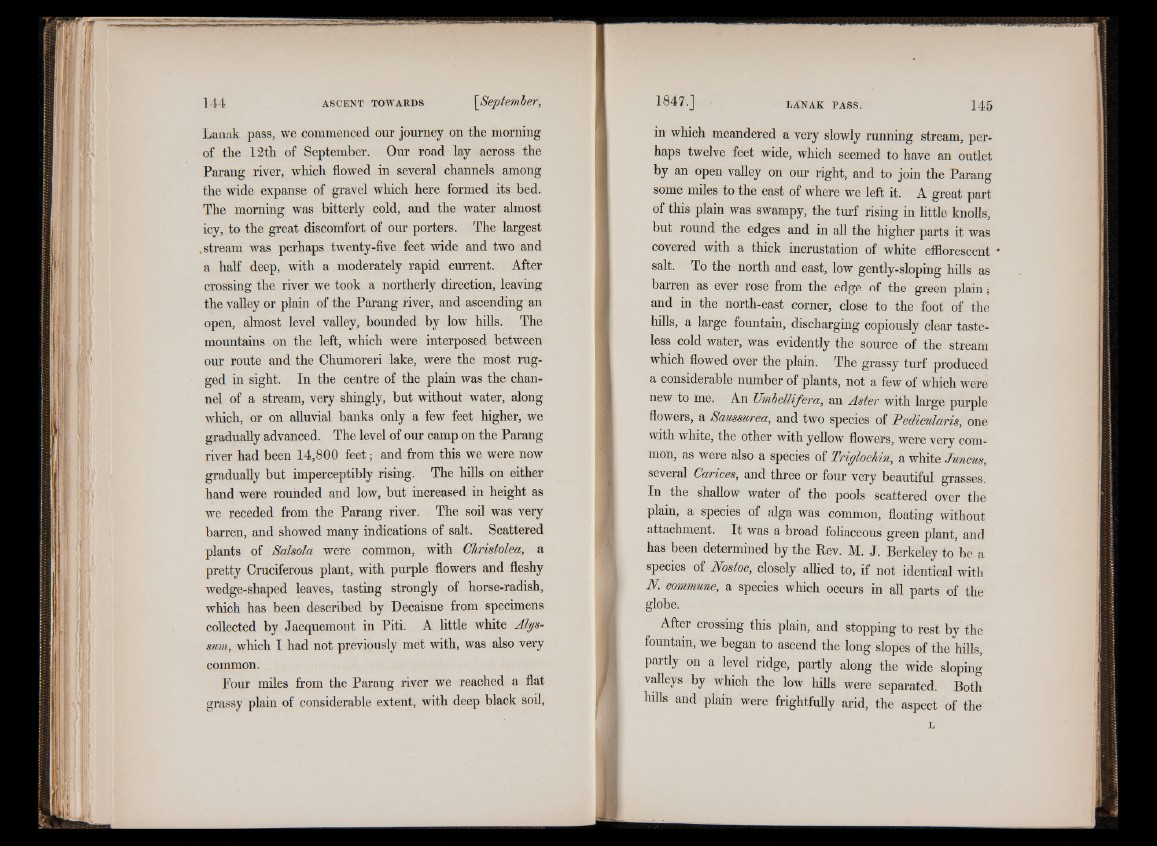
Lanak pass, we commenced our journey on the morning
of the 12th of September. Our road lay across the
Parang river, which flowed in several channels among
the wide expanse of gravel which here formed its bed.
The morning was bitterly cold, and the water almost
icy, to the great discomfort of our porters. The largest
.stream was perhaps twenty-five feet wide and two and
a half deep, with a moderately rapid current. After
crossing the river we took a northerly direction, leaving
the valley or plain of the Parang river, and ascending an
open, almost level valley, bounded by low hills. The
mountains on the left, which were interposed between
our route and the Chumoreri lake, were the most rugged
in sight. In the centre of the plain was the channel
of a stream, very shingly, but without water, along
which, or on alluvial banks only a few feet higher, we
gradually advanced. The level of our camp on the Parang
river had been 14,800 feet; and from this we were now
gradually but imperceptibly rising. The hills on either
hand were rounded and low, but increased in height as
we receded from the Parang river. The soil was very
barren, and showed many indications of salt. Scattered
plants of Salsola were common, with Christolea, a
pretty Cruciferous plant, with purple flowers and fleshy
wedge-shaped leaves, tasting strongly of horse-radish,
which has been described by Decaisne from specimens
collected by Jacquemont in Piti. A little white Alys-
sum, which I had not previously met with, was also very
common.
Pour miles from the Parang river we reached a flat
grassy plain of considerable extent, with deep black soil,
in which meandered a very slowly running stream, perhaps
twelve feet wide, which seemed to have an outlet
by an open valley on our right, and to join the Parang
some miles to the east of where we left it. A great part
of this plain was swampy, the turf rising in little knolls,
but round the edges and in all the higher parts it was
covered with a thick incrustation of white efflorescent •
salt. To the north and east, low gently-sloping hills as
barren as ever rose from the edge of the green plain;
and in the north-east corner, close to the foot of the
hills, a large fountain, discharging copiously clear tasteless
cold water, was evidently the source of the stream
which flowed over the plain. The grassy turf produced
a considerable number of plants, not a few of which were
new to me. An JJmbellifera, an Aster with large purple
flowers, a Saussurea, and two species of Pedicularis, one
with white, the other with yellow flowers, were very common,
as were also a species of Triglochin, a white Juncus,
several Carices, and three or four very beautiful grasses.
In the shallow water of the pools scattered over the
plain, a species of alga was common, floating without
attachment. It was a broad foliaceous green plant, and
has been determined by the Rev. M. J. Berkeley to be a
species of Nostoc, closely allied to, if not identical with
N. commune, a species which occurs in all parts of the
globe.
After crossing this plain, and stopping to rest by the
fountain, we began to ascend the long slopes of the hills,
partly on a level ridge, partly along the wide sloping
valleys by which the low hills were separated. Both
hills and plain were frightfully arid, the aspect of the